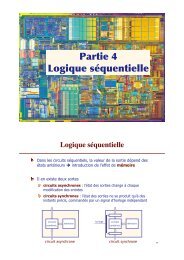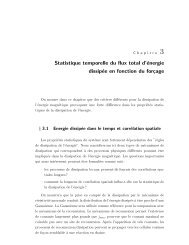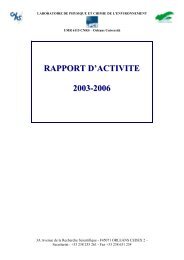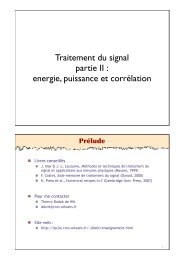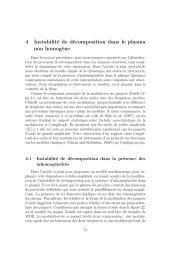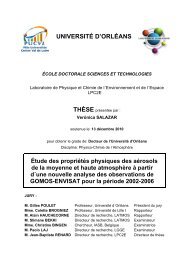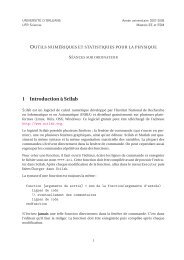UNIVERSITÉ D'ORLÉANS - Laboratoire de physique et chimie de l ...
UNIVERSITÉ D'ORLÉANS - Laboratoire de physique et chimie de l ...
UNIVERSITÉ D'ORLÉANS - Laboratoire de physique et chimie de l ...
You also want an ePaper? Increase the reach of your titles
YUMPU automatically turns print PDFs into web optimized ePapers that Google loves.
B<strong>et</strong>ween 46.4 hPa and 10.0 hPa (i.e. ~21 km and 31 km) the percentage differences are<br />
0.4±5.5% on average for June 2005 and 6.5±26.8% on average for June 2008. Despite the<br />
major differences b<strong>et</strong>ween the remote and in situ m<strong>et</strong>hods and the geographical distance<br />
b<strong>et</strong>ween the two measurements, these comparisons indicate a very good agreement b<strong>et</strong>ween<br />
SPIRALE and MLS in the tropical middle stratosphere, without any systematic bias. Low<br />
HCl mixing ratios for pressures larger than 46.4 hPa (< 21.1 km) lead to a poorer agreement<br />
b<strong>et</strong>ween the two instruments where the MLS HCl mixing ratios are less accurate (see section<br />
2.2). A comparison of MLS HCl measurements with in situ aircraft ones has been performed<br />
up to ~18.8 km (68 hPa) and revealed a rather mediocre agreement (Froi<strong>de</strong>vaux <strong>et</strong> al., 2008).<br />
In the same study, other remote (MkIV, FIRS-2) and in situ tunable laser dio<strong>de</strong> (ALIAS-II)<br />
balloon-borne measurements yiel<strong>de</strong>d good agreement (≤ 10% difference) with those of MLS<br />
from the middle to the upper stratosphere (≥ 21.1 km) where HCl abundances are larger, but<br />
again, poorer agreement (about 20 to 40% difference) at lower altitu<strong>de</strong>s. As a conclusion,<br />
MLS measurements of HCl are essentially valid in the tropical middle and upper stratosphere,<br />
as <strong>de</strong>monstrated by SPIRALE and other balloon-borne instruments.<br />
Froi<strong>de</strong>vaux <strong>et</strong> al. (2008) also compared the MLS HCl measurements to other satellite<br />
instruments (HALOE and ACE-FTS). They found MLS HCl values ~7 to 20% larger than<br />
those of HALOE for the whole stratosphere, consistent with previous studies illustrating a<br />
similar offs<strong>et</strong> in HALOE measurements (Russell <strong>et</strong> al., 1996; McHugh <strong>et</strong> al., 2005). Over a<br />
great range of latitu<strong>de</strong>s and longitu<strong>de</strong>s including thousands of collocated measurements, ACE<br />
HCl values have been shown to be 2 to 10% larger than MLS ones from 50 to 10 hPa (~21–31<br />
km) and from 1 to 0.2 hPa (~48–55 km). On the other hand, a SPIRALE single profile<br />
recor<strong>de</strong>d at high latitu<strong>de</strong> (near Kiruna, 67.6°N–21.5°E) in January 2006 was compared to a<br />
ACE-FTS profile collocated 413 km away. The agreement was fairly good in the altitu<strong>de</strong><br />
range where the SPIRALE HCl measurements were not perturbed by the presence of a polar<br />
stratospheric cloud (Grossel <strong>et</strong> al., submitted), i.e. from 16.5 to 19.5 km and from 23.5 to 27.5<br />
km, but with a slight positive bias (ACE-SPIRALE) of about 4–11%. In summary, ACE<br />
measurements are larger by about 7±4% than SPIRALE and MLS values b<strong>et</strong>ween 21 and 31<br />
km height and than MLS values b<strong>et</strong>ween 48 and 55 km. Among these satellite measurements<br />
at about 53 km, the MLS value were found in excellent agreement with calculated HCl vmr<br />
based on tropospheric measurements of ground-based n<strong>et</strong>works and mo<strong>de</strong>lling including<br />
long-lived source gases and 100 pptv of VSLS contribution (Froi<strong>de</strong>vaux <strong>et</strong> al. 2006), whereas<br />
the ACE values were larger than calculated HCl values by about 200 pptv. The very good<br />
123



